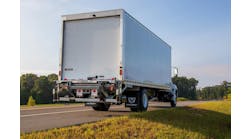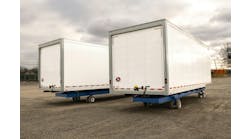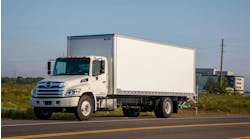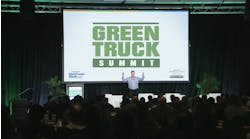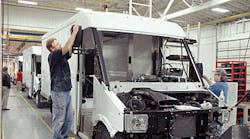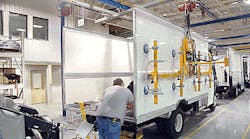FLEETS appreciate a good price for a truck body. But increasingly they are looking beyond the initial purchase price of the truck and considering the total cost of ownership.
They want a small cost for the big picture. They know that the purchase price of the truck body is merely one element that they need to evaluate.
So what are these costs, and what can a truck body manufacturer do to help customers lower each of them? There are a variety of cost involved in owning and operating a commercial vehicle. Recently a chassis manufacturer has teamed up with a truck body manufacturer to do develop a delivery truck that addresses them. After several years of research and development, the results of the project are now in production.
Isuzu and Utilimaster first began talking about working together to address this in 2005. They began working on a joint project in 2007, and finally began seeing fruit from their efforts in 2011.
The result of the project is the Reach, a delivery truck that the companies believe will lower overall costs for the fleets that operate them.
The Reach debuted at last year's Work Truck Show. Since then, customers have placed orders, and Utilimaster has ramped up production. To announce the official start of production, the two companies held an open house October 25. Customers, suppliers, and executives from Isuzu, Spartan Motors (Nasdaq: SPAR, Utilimaster's parent company) and Utilimaster attended. Some executives from Isuzu flew in from Japan for the event.
Team effort
The concept for the Reach goes back to 2005 when Isuzu and Utilimaster developed a new walk-in van concept that could be sold to companies such as Federal Express, United Parcel Service, Purolator, Frito-Lay, and Verizon.
The companies spent a lot of time talking to customers about their needs and how conventional walk-in van designs could be modified to better serve those needs. For example, they created a model of the proposed vehicle in 2008, followed by a full-sized mock-up.
Isuzu and Utilimaster held a customer clinic in Detroit late in 2008 to evaluate customer response to the Reach. The event lasted a week during which Isuzu and Utilimaster reviewed specifications with customers and gained their feedback.
Based on the response, a number of improvements were made, including making the truck four inches wider than was originally proposed.
Then came 2009. The project was briefly placed on hold as the economic storm shook the truck market. But work on the Reach resumed later in the year after a four-month lull.
In the first half of 2010, prototypes were built. The first was completed in July, followed by 13 test units. Seven of the trucks were shipped to Japan for testing on the truck manufacturer's proving grounds in Hokkaido.
“We did some early ride-and-drives with these units,” Marshall says. “Customers were involved throughout the development process to make sure the vehicle addressed owner and operator needs.” The rest of the test units remained in the United States. Emissions testing was a key concern. Utilimaster conducted tests internally, along with sending test units to the Bosch Automotive proving grounds in New Carlisle, Indiana.
In addition to the 13 test and evaluation vehicles that Isuzu and Utilimaster used, 10 trucks went to FedEx and UPS to evaluate in route operation until April 2012.
Delivering the goods
The Reach is designed as a suburban and rural delivery vehicle. Parcel delivery fleets tend to use their larger trucks in urban applications where they may spend the entire day going only 20 miles. In that environment, aerodynamics and other cost-saving features of the Reach are not as important.
“When trucks that run 200 miles or more per day, the Reach is performing at its best,” Marshall says.
The truck is not designed to compete with large van bodies. The largest cargo capacity that Isuzu and Utilimaster offer is 630 cubic feet — a 14-ft van.
When the deliveries are scattered, the truck does not need massive cargo capacity. Delivering 630 cubic feet of packages can take an entire day in some routes.
“The truck is a tool to perform a job,” Marshall says. “The better we as truck and body manufacturers understand the applications the customer uses the tools we build, the better we are able to provide value.”
Targeted cost reduction
In developing the Reach, Isuzu and Utilimaster looked at each of the costs associated with operating the tool that they were planning to build:
- Initial cost
In the big picture, this is an element, but not necessarily the most costly item.
- Fuel economy
While normally thought of as primarily a function of the chassis, the truck body also plays a role — especially in terms of tare weight and aerodynamics. Utilimaster says the Reach reduces aerodynamic drag 13% when compared with the company's conventional walk-in van. According to Utilimaster, every one percent reduction in aerodynamic drag results in a half-percent improvement in fuel economy. Therefore, the 13% reduction in air drag is good for an approximate 6% gain in fuel economy.
- Weight
Simple physics tell us that a body at rest tends to stay at rest unless acted upon by an outside force. For a parked truck, that outside force comes from gasoline. The less the mass, the less energy required. Utilimaster uses a combination of automotive composites and aluminum to reduce the weight of the Reach by 700 pounds‥
- Service and maintenance
Fleet managers are less familiar with the automotive composites Utilimaster uses in the body and the smaller engine that Isuzu uses to power the chassis. By providing potential customers with test units, Utilimaster and Isuzu are attempting to demonstrate the durability of these lesser known components of the Reach.
- Operator safety and productivity
The driver, along with fuel, is the fleet's largest expense — particularly in operations where the driver makes as many as 50 stops per day. Based on input from fleets, Utilimaster made the main driver entry door four inches wider. The company also installed (and later refined) a grab hand rail designed to make entry into the cab a little easier. Anti-slip steps, made of fiberglass and a layer of carbide and a top coat to secure the carbide, improve traction.
A frugal powertrain
The Reach is powered by a four-cylinder, three-liter Isuzu diesel engine.
“Until the Reach, a -6.7 liter engine was the smallest offering for this type of application,” Marshall says. “That's more than twice the displacement. Our fleets have long been asking for smaller engines because their loads do not require that much horsepower. This Isuzu drivetrain has been available in the United States since the mid-1980s.”
Isuzu couples the engine with a programmable six-speed Aisin automatic transmission.
“It's a very nice transmission,” Marshall says. “It is the same transmission that's used behind the five-liter engine, so it certainly handle a three-liter.”
Working with composites
Much of the Reach is made of different types of automotive composites. Cladding, for example, is made of reaction injected molded (RIM) plastic — a flexible material that resists cracking and impacts. The cladding is painted for UV protection, but with the same color as the RIM material itself so that scratches to the paint simply reveal the base material.
“The process involves molding polyurethane at low pressure,” says Tim Marling, director of design engineering.
The female side of the mold is painted and then the material is injected into the mold. When the part is removed from the mold, it comes out painted. The paint chemically bonds to the material during the curing process.
At present, the cladding used on the Reach is grey, but Utilimaster could offer different colors should higher volumes make that feasible.
“We use exposed fasteners for quick replacement,” Marling says. “That would not be the case if we were building an automobile, but fleet managers appreciate the ability to service the truck quickly.”
Other composites
Closed-mold fiberglass is used for the hood and roof.
“We are seeing a move away from translucent roofs,” Marshall says. “In places such as Arizona, heat gain is especially undesirable because it's uncomfortable for the driver and undesirable for grocery clients that transport perishable products. Instead of specifying a translucent roof, they are asking for interior LED lighting. LED lighting requires little power and requires very little maintenance. And by using motion sensors in the cargo area, the need for monitoring battery voltage is virtually eliminated‥”
Sidewalls are made of composite panels. The one-piece panels consist of polyester skin and a polyester honeycomb core. The panels are not laminated; they are produced in a single process that embeds the paint color behind an acrylic gloss coat that is five times thicker than the clear coats offered by automotive painting processes.
Floors also are one-piece composite panels. Approximately two inches thick, the panel consists of a series of composite planks wrapped in fiberglass. The hollow planks are placed in a mold and injected with polyester resin. The result is a panel that has a series of vertical beams that perform the work of cross sills — without the need to install metal cross sills.
As with other walk-in vans, the Reach must have a dashboard supplied by the truck body manufacturer. Utilimaster uses two pieces of molded polyurethane — the same durable material that is used for the front bumper.
“Plastic offers us acoustical and thermal advantages,” says Tim Marling, director of design engineering. “It leads to a much quieter truck. Sidewalls of a walk-in van act like a big speaker if they aren't rigid. We are convinced that this design really dampens the vibrations of the sidewalls and floor and creates a superior environment for the driver.”
Utilimaster uses sheet-molded compound (SMC), a structural plastic, to separate the engine compartment from the cab.
“This material does a good job of insulating the engine compartment,” Marling says. “But the Isuzu engine is quiet to begin with. Truck manufacturers have had to reduce emissions a lot in recent years. And as emissions have decreased, so have noise levels.”
Custom chassis
The Reach is based on Isuzu's NPR chassis. However, this particular version is available only for the Reach.
The Reach required Isuzu to reposition a number of components on its chassis — including the position of the engine.
“To make everything work, the engine had to be moved forward 10 inches,” Marling says. “And when the engine had to be moved, Isuzu had to perform some recalibrations to make sure the truck still met emissions regulations.”
In spite of the work Isuzu did to modify the NPR chassis for use with the Reach, Utilimaster still has a number of tasks to perform to get the vehicle ready for the assembly line.
“The chassis has to be capable of being driven on the loading dock,” Marling says. “So there are a lot of temporary components that we have to take care of when it gets here.”
Those include temporary seats, headlights and taillights, and a structure that supports the steering column.
Ready for production
Utilimaster added 5,000 square feet to one of its plants in order to be ready to produce the Reach. The addition included space for a warehouse and to remove and/or relocate the temporary components that are installed on the chassis when it arrives at the Utilimaster plant.
Not including the warehouse and chassis prep area, Utilimaster manufactures the Reach in an 86,000-sq-ft plant that has recently been retooled to produce the new product.
Major assembly stations include chassis prep, installation of the frame risers and mounting brackets, installation of the cab and cargo floor, installation of the rear doors, door frame and front bulkhead if specified. Farther down the line, the pre-assembled sidewalls are installed, followed by the roof.
With the basic structure in place, Utilimaster then works on the dash and interior trim, followed by any cargo control options such as shelving and logistical tracks. At the end of the line, the hood is mounted and cladding installed.
“At each station, we try to have work going on at the front and rear of the truck,” says Barry Simes, director of manufacturing. “We want to space out the activity so that people do not interfere with one another.”
Target market
The Reach is being targeted for use by major delivery fleets who buy in quantity. As such, it was particularly important for the company to tool up properly for production of the Reach.
“We faced a few challenges,” says John Marshall, Utilimaster senior vice-president, sales and marketing. “We invested time debugging fixtures and tweaking parts to make sure that everything went smoothly once we officially began production.”
